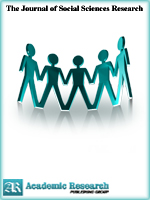The Journal of Social Sciences Research
Online ISSN: 2411-9458
Print ISSN: 2413-6670
Print ISSN: 2413-6670
Quarterly Published (4 Issues Per Year)

Archives
Volume 1 Number 8 December 2015
Changes in the Governance System for Higher Education in Peru to Meet the Challenges of the 21st Century
Authors: Chiyon Isabel ; Yague Jose Luis ; Gomez-Gajardo Francisca
Pages: 109-118
Abstract
The competition in markets, the distribution of limited resources based on productivity and performance, and the efficient management of universities are changing the criteria of trust and legitimacy of the educational system in Peru. Universities are perceived more as institutions of the public sector, while the services they offer must rather contribute to the modernization of the emerging society and the knowledge economy. Higher Educations reforms - initiated in the 1980s - have been inspired by the successful university organizations that have managed to change their governance and addressed to transform certain bureaucratic institutions into organizations capable of playing active role in this global competition for resources and best talent. Within this context, Peruvian universities are facing two major challenges: adapting themselves to new global perspectives and being able to develop a better response to society demands, needs and expectations. This article proposes a model of governance system for higher education in Peru that gives a comprehensive solution to these challenges, allowing dealing with the problems of universities for their development and inclusion within the global trends. For this purpose, a holistic and qualitative methodologic approach was developed, considering an integrated method which considered educational reality as a whole, understanding its facts, components and elements that affects its outcomes. It is proposed to define a policy for university education in Peru that permeates society, by changing the planning model from a social reform model to a policy analysis model, where the Peruvian State acts as sole responsible for responding to the demanding society as its legal representative complemented with some external and independent bodies that define the basis of best practice, as it is being done in many university models worldwide.
Trauma and Resiliency in Social Work Degree Candidates
Authors: Rene M. McCoy ; Bruce A. Thyer ; Raymond J. Waller ; J. L. Nelson
Pages: 102-108
Abstract
Exposure to traumatic events sufficient to result in symptoms is a common phenomenon within the general public. Extrapolation of this observation to clinical social work students in training is reasonable, though unsubstantiated, at a time when this area of practice is expanding. Untreated trauma symptoms in students have the potential to harm both students and their clients, though little data exits on the prevalence of such events in students or on predicting symptom manifestation. Resiliency is a cluster of behavioral phenomena associated with recovery from trauma in the general population, but this assumption has lacked empirical investigation in degree candidates in the field of social work. Using the Ego-Resiliency Scale, the Trauma Recovery Scale, part of the Traumagram, and the Impact of Events Scale – Revised, exposure to trauma and the predictive value of resiliency for social work students from Florida State University was investigated. Findings show that resiliency and symptoms of posttraumatic stress were inversely related, but this relationship was not statistically significant. These findings provide evidence that resiliency may occur simultaneously with symptoms of trauma. They further suggest that students may be entering a specialty area of practice susceptible to unresolved trauma, risking their own health and potentially impairing optimal client outcomes.
Stamatis Generic Model and Audit Quality in Nigeria
Authors: Kenneth Enoch Okpala
Pages: 94-101
Abstract
Due to the frequent business failure coupled with incessant malpractices and increase in fraud techniques, there is a need for auditors to improve audit quality to address these negative occurrences. This study investigated the application of Stamatis generic model as a continuous quality improvement technique to influence audit quality in Nigeria. The population consists of 916 licensed auditing firms in Nigeria and 683 was the sample size upon which questionnaire was administered. 641 copies of questionnaire were returned representing a response rate of 94%. The questionnaire was validated by certified quality management. The reliability and internal consistency of the instrument for data collection was confirmed by the Cronbach’s Alpha reliability coefficients (Rc) of 82% obtained from pilot study. Pearson product moment correlation coefficient was used to confirm the research hypotheses. The result obtained showed positive correlations and statistically significant relationships among the level of Stamatis generic model awareness and degree of implementation (r =.752; p =.000) and the application of Stamatis generic model and audit quality (r =.630; p =.000). Findings show that though the model theoretically predicted audit quality but are yet to be implemented by auditors in Nigeria as a result of ignorance, inexperience and low level of firms’ resources. The study concluded that Stamatis generic model will improve the quality of auditor’s reports if implemented and through multiplier effect, influences the integrity of financial statements and stakeholders’ decision. It was recommended that audit firms should adopt SGM to have quality output and satisfied clients.



